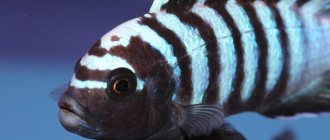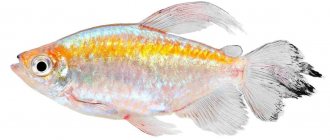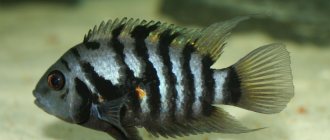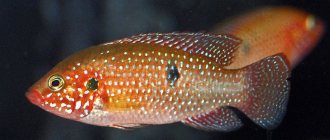The Pseudotropheus zebra fish, belonging to the Cichlid family, lives in Lake Malawi in East Africa. It is very popular among aquarium owners because it has a bright, remarkable appearance and interesting behavior. In an artificial reservoir, representatives of the species immediately form a strict hierarchy of relationships. Watching the life of fish is very fascinating.
Description
The body size of the aquarium fish is average, from 10 to 15 cm. The body is elongated, slightly flattened on the sides. The head is large. The lips are voluminous. The eyes are big. The fin on the back is long.
There are more than 50 varieties of the African species, differing in external characteristics, but four are bred in aquariums.
- Red. Males are blue, females are red. The body is decorated with 7 or 9 vertical stripes. The anal fins have yellow spots with black edges. There is also a variety in which individuals of both sexes have a red body. Red fish are the calmest and friendliest among all representatives of the species, although in nature this color is considered a sign of aggression.
- Blue. The most popular variety. The color is light blue, rich, the body is decorated with dark stripes. In older males, the color of the scales fades.
- Yellow-orange. The fish are bright and attractive due to their rich orange-yellow color. The anal fins are decorated with dark spots.
- Snowflake (white). An original variety, bred artificially: albinos of this species do not exist in nature. The body is white, slightly tinged with blue. The eyes are red.
Red aquarium zebra
The body shape of this aquarium fish bears a significant resemblance to a torpedo. Coloration varies from red-blue to light red-orange. The maximum body length reaches eighty millimeters. The red zebra is not an aggressive species, but it is not friendly towards its neighbors in the aquarium. At the same time, red pseudotropheus is unpretentious in care and can easily adapt to a variety of conditions. The lifespan of the red zebra fish is approximately ten years.
Care and maintenance
Since representatives of the species are characterized by a hierarchical lifestyle and strict territorial division, the artificial housing must be spacious (the minimum volume for one flock is 150 liters). The shape of the aquarium is rectangular, length from 1.2 m. The aquarium decor should include shelters.
Otherwise, pseudotropheus are unpretentious and do not require specific care and maintenance.
Water parameters
Fish are comfortable in water that has the following parameters:
- temperature 25 – 28°C;
- hardness 5 – 20°;
- acidity 7.5 – 8.5 pH.
An aeration system and a good filter must be installed. Pseudotropheus love water saturated with air; it needs to be changed weekly by 30% of the volume. The water must be settled.
Lighting
Comprehensive lighting. Fluorescent and incandescent lamps are used.
Plants
The aquarium must be generously decorated with vegetation. You should buy plants with a strong root system and thick leaves so that herbivorous “zebras” cannot eat them.
Decor
Should resemble the conditions of a natural reservoir. The bottom of Lake Malawi is rocky. When arranging, the bottom of the aquarium is decorated with small and large stones, caves, various shelters and passages are organized. You can put some driftwood.
Seda habitat
Endemic to Lake Nyasa (Malawi), located in a rift valley on the African continent on the border of the states of Mozambique, Malawi and Tanzania.
The fish is found along the northern coast among piles of stones and rocks. Brief information:
- Aquarium volume - from 150 liters.
- Temperature - 24–28°C
- pH value – 7.6–8.8
- Water hardness - medium and high hardness (8–25 dGH)
- Substrate type - sandy, rocky
- Lighting – dim or moderate
- Brackish water - no
- Water movement - weak to moderate
- The size of the fish is about 13 cm.
- Nutrition - any food with herbal supplements
- Temperament - quarrelsome
- Keeping in a harem with one male and several females
Compatibility and Behavior
Pseudotropheus zebra is an aggressive species. Pisces do not allow strangers into their clearly limited territory. Males often start fights for one or another piece of territory. Therefore, it is recommended to form a flock consisting of one male and several females. The optimal number of individuals in a flock is 6 – 8.
The behavior of "zebras" is conflicting. The only neighbors with whom compatibility is more or less normal are other representatives of the Cichlid family, but they are not large.
Feeding
You can also use store-bought food designed specifically for this type of fish.
Under natural conditions, fish feed mainly on algae, sometimes supplementing their diet with plankton. In an aquarium, the pseudotropheus zebra should receive 70% of plant food in the total volume of food, the main of which should be lettuce, nettle, cabbage and sweet peppers. Vegetable foods should be crushed and scalded so that they become soft enough for the fish to eat them. The remaining 30% of the diet is live food. The best options are bloodworms, daphnia and coretra. Once a week it is useful to give a little black bread. You can also give the fish dry and frozen food, but this will make their color dull.
Breeding and reproduction
The male and female form a pair only for spawning. Pseudotropheus reaches sexual maturity at 10–12 months. There is no need to build a spawning aquarium for breeding. In a general aquarium, a drainage system with wide pipes is installed at the bottom.
During the breeding process, the female lays up to 100 eggs, 4 mm in diameter. The eggs are gestated in the mother's mouth for 18–20 days. The hatched grayish-brown fry feed on small planktonic food. They acquire a bright color by 6 months of life.
What do these “mbuns” eat?
To the surprise of novice aquarists, the red zebra prefers fresh vegetable food. Conscientiously crushed and formed into balls, it can be swallowed whole by a large mouth. Products prepared with spirulina, cyclops, shrimp, minced fish and other seafood will also be eaten with appetite. From food enriched with special vitamins and microelements, the color of the skin will become brighter, the size will become larger, and the mood will become more active.
Given their predatory nature, zebra cichlids can get their own food, especially if small fish live in the same aquarium with them and their spawning or viviparity occurs.
It should be noted that the appetite of healthy fish is significant. They eat so much that they exceed their own needs. Therefore, feed should be given sparingly, regularly cleaning the water from residues.
Diseases and prevention
How long pseudotropheus live depends on the conditions, but usually up to 5 years. They are hardy and have good health. The only common problem is injuries received during territorial fights. In order for wounds on the body to quickly heal, you should add salt (3 g per liter) and methylene blue (until the water turns pale blue) to the aquarium.
Less commonly, at home, “zebras” suffer from parasitic diseases: ichthyophthyriasis (the parasite lives under the skin) and Malawi disease (the digestive tract is affected). In the first case, to prevent the death of pets, malachite grun is dissolved in water, and the temperature is lowered by 5°C. In the second case, there is no cure or prevention, the fish dies.
Pseudotropheus are beautiful and unpretentious fish, suitable for a voluminous, green-rich aquarium. Watching their lives and relationships is great fun.
Motherland
Under natural conditions, pseudotropheus zebra lives in Lake Malawi, which is located in East Africa. Prefers coastal rocky and rocky areas for shelter from larger predators. It lives in the middle water column , where phyto and zooplankton and aquatic vegetation are found.
Pseudotropheus love spacious aquariums, in which they happily swim along the walls in the middle layers.
Cohabitation
As you know, pseudotropheus cannot boast of a friendly character, so living together with other species rarely ends well
If you want to breed various creatures in your aquarium, it is important to adhere to several rules and recommendations
Cohabitation of zebras with other species rarely ends well, so it is better to keep them separately
First, you need to remember that in one group there should be a male and several females, preferably 2-3 individuals. In this case, the innate level of aggressive behavior will be significantly reduced.
If you want to populate a container with different fish, it is better to give preference to African species with a less pugnacious character. It would be very good if these were inhabitants of Lake Malawi with different sizes and colors. Otherwise, zebras will begin to show territoriality and will conflict with their neighbors.
If you want to expand your aquarium colony, then to do this you need to take several measures and provide the creatures with the proper conditions. Puberty of the species ends at the age of 8-12 months, after which individuals begin to show special interest in the opposite sex, courting females.
During the spawning period, they need a calm, relaxed atmosphere
There are times when an aquarist waits impatiently for new offspring of zebra fish to be born, but, unfortunately, this does not happen. To solve the problem, the most aggressive individual should be separated from the females, because during the spawning period they need a calm, relaxed atmosphere. A good stimulation for rapid reproduction will be increased nutrition. It is enough to try feeding your pets a little more often than usual.
Without a doubt, Pseudotropheus zebra is a real find for fans of aquarium fish. Her beauty and grace simply have no equal. At the same time, the creature does not require special care and easily takes root in every aquarium. If you understand the basic features of caring for pseudotropheus, then in a short period of time it will be possible to grow and breed an entire colony of fabulous representatives of the tropical ichthyofauna.
External characteristics
The body shape is a slightly oblong oval. Cichlazoma has a bright appearance: a large mouth in a downward position, large round black eyes with a golden border, a wide smooth forehead. The dorsal and anal fins stretch along the body, the outer rays (in the area of the tail) are pointed. The caudal fin is of harmonious size, without excesses.
The description of the colors of the black-striped cichlazoma currently includes several hybrid forms bred in captivity. The classic color is blue-gray with oblong black spots and transverse stripes. Due to the irregularity of the stripes, breaks and their bizarre shape, the fish are called “zebra cichlids”. Usually there are 8-9 stripes. The fins are transparent, with a barely noticeable yellow tint. Sometimes yellow-orange sparkles are possible on the fins and scales. In some individuals, the spots extend to the dorsal fin.











